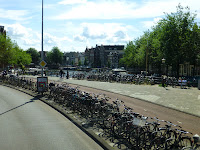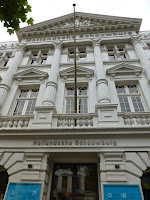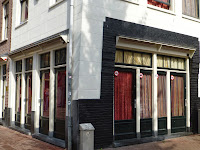 Amsterdam is the capital of the Netherlands. However, the Dutch government is actually located at The Hague. Amsterdam has over 805,000 residents and is the largest city. The larger metro area is home to more than 2.3 million people.
Amsterdam is the capital of the Netherlands. However, the Dutch government is actually located at The Hague. Amsterdam has over 805,000 residents and is the largest city. The larger metro area is home to more than 2.3 million people. In the 12th century, Amsterdam started out as a small fishing village. Humble beginnings for what became one of the world's most important ports.
In the 12th century, Amsterdam started out as a small fishing village. Humble beginnings for what became one of the world's most important ports. The city is famous for its canals. There are more than 100 km (62 miles) worth of canals and 1,500 bridges. The main canals were dug in the 17th century. In 2010, they were added to the UNESCO World Heritage List.
The city is famous for its canals. There are more than 100 km (62 miles) worth of canals and 1,500 bridges. The main canals were dug in the 17th century. In 2010, they were added to the UNESCO World Heritage List. 
This is probably the most bicycle-friendly city I've ever been to. There are about 1.2 million bikes in Amsterdam so they actually outnumber the people living in the city. The cost of an average new bike runs €600 ($825).
.jpg) Bicycle theft is a huge problem. This explains why for everyday use most people ride around on bikes which seem rather battered. Use the cheap bike to get from place to place and keep the expensive bike for serious riding.
Bicycle theft is a huge problem. This explains why for everyday use most people ride around on bikes which seem rather battered. Use the cheap bike to get from place to place and keep the expensive bike for serious riding. The 15th century Nieuwe Kerk (New Church) is used for royal weddings and coronations. Religious services are no longer held but is now a popular exhibition space.
The 15th century Nieuwe Kerk (New Church) is used for royal weddings and coronations. Religious services are no longer held but is now a popular exhibition space..jpg) The palace was built in the 17th century as a city hall. Completed in 1665, it became the royal palace. For quite some time it was the largest administrative building in Europe. Today the Dutch Royal Family reside in The Hague.
The palace was built in the 17th century as a city hall. Completed in 1665, it became the royal palace. For quite some time it was the largest administrative building in Europe. Today the Dutch Royal Family reside in The Hague.
The National Monument was completed in 1956. It is a memorial to the victims or WWII and a monument to liberation and peace.
De Gooyer is the country's tallest wooden windmill. It is a registered national monument.

The Portuguese Synagogue was completed in 1675. At the time, the 17th century Sephardic synagogue was one of the largest in the world.
 The Hollandsche Schouwburg (Dutch Theater) is a memorial to the Dutch Jews who were murdered during WWII. In the summer of 1942 the Nazis used it as an assembly point before Jews were sent on to a transition camp. Between 60,000 - 80,000 people were sent on to concentration camps.
The Hollandsche Schouwburg (Dutch Theater) is a memorial to the Dutch Jews who were murdered during WWII. In the summer of 1942 the Nazis used it as an assembly point before Jews were sent on to a transition camp. Between 60,000 - 80,000 people were sent on to concentration camps. The Anne Frank House is a museum dedicated to the life and times of Anne Frank. The museum opened in 1960. It was amazing to actually be in the secret hiding place where Anne Frank and others hid from Nazi persecution during the occupation. There's no photography allowed inside so here's a short video I found on YouTube.
The Anne Frank House is a museum dedicated to the life and times of Anne Frank. The museum opened in 1960. It was amazing to actually be in the secret hiding place where Anne Frank and others hid from Nazi persecution during the occupation. There's no photography allowed inside so here's a short video I found on YouTube.
©Rick Steves
 The Rijksmuseum is the Dutch national museum dedicated to arts and history. It was founded in The Hague in 1800. In 1808 it was moved to the Royal Palace. The current location was opened in 1885 but closed for renovation from 2003 to 2013 at a cost of €375 million ($515 million).
The Rijksmuseum is the Dutch national museum dedicated to arts and history. It was founded in The Hague in 1800. In 1808 it was moved to the Royal Palace. The current location was opened in 1885 but closed for renovation from 2003 to 2013 at a cost of €375 million ($515 million)..jpg) |
| Vermeer's The Milkmaid |
Fortunately it opened in April of this year so I was able to enjoy it on this visit and see the works of two of my favorite artists - Rembrandt van Rijn and Johannes Vermeer.
The Company of Captain Frans Banning Cocq and Lieutenant Willem van Ruytenburch Preparing to March Out became commonly known as The Night Watch in the 18th century. It is one of the most famous paintings in the world.

At Rembrandt Square is a 3D version of The Night Watch.

Taxes were based on the width so most houses were built tall and skinny. This means that staircases are tight and narrow, and almost impossible to move bulky furniture upstairs.
 Houses have a large arm and hook at the top so that furniture can be more easily moved. Houses were also built with a slight forward lean so that it minimizes the chance of furniture colliding with the front of the building on the way up.
Houses have a large arm and hook at the top so that furniture can be more easily moved. Houses were also built with a slight forward lean so that it minimizes the chance of furniture colliding with the front of the building on the way up.  I'm sure that it's much wilder at night but it's pretty calm during the day. Photography isn't allowed of the women working in the shop windows but here's a discrete photo taken at a distance.
I'm sure that it's much wilder at night but it's pretty calm during the day. Photography isn't allowed of the women working in the shop windows but here's a discrete photo taken at a distance.

























No comments:
Post a Comment